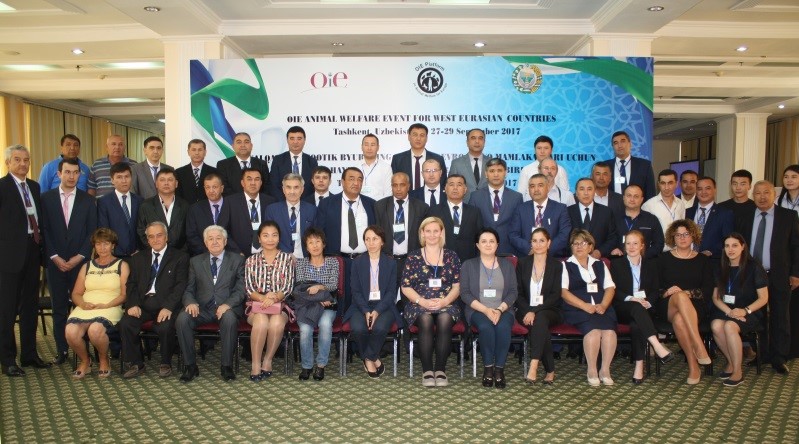The OIE Platform on animal welfare for Europe organised the Second workshop on stray dog population and rabies control in West Eurasia countries (SDWE2) in Tashkent/Uzbekistan on 28-29 September 2018.
This workshop is an integral activity of the Regional stray dog Roadmap on for West Eurasia, launched in October 2015, with the objective to become compliant with OIE chapter 7.7 by 2030.
Seven West Eurasian countries attended the meeting, namely: Armenia, Azerbaijan, Georgia, Kazakhstan, Kyrgyzstan, Tajikistan and Uzbekistan. Only Turkménistan did not attend.
The Workshop objectives:
The workshop aimed to review progresses made by the Member Countries over the past two years in achieving the agreed Regional Vision and to provide additional technical guidance in stray dog population and rabies control, in order to improve their compliance with OIE standards (Chapter 7.7 and Chapter 8.14). Other objectives of the workshop were to:
As part of the workshop preparatory activities, countries were requested to conduct during the 2nd semester of 2015 and the 1st semester of 2016their first self-assessment using the OIE stray dog Self-Assessment and Monitoring (SAM) Tool, as a way to establish their national Baseline situation, and from there, measure progress overtime (more information)
Based of the country self-assessment results, the OIE in collaboration with IZSAM Teramo prepared the SDWE2 agenda and developed eight National stray dog Reports. These National Reports provide a comprehensive overview of national stray dog and rabies situation. They aslo propose a way forward to build a national stray dog roadmaps to contribute to the achievement of the regional stray dog Vision by 2030, and the zero human deaths from dog-mediated rabies by 2030.
The National Reports were distributed to the countries before the SDWE2 Workshop as the main preparatory document, and as a guide for individual country interviews during the workshop.
The celebration of the World Rabies Day at the Veterinary Department of the Tashkent State Agrarian University was integral part of the workshop. The celebration event included lectures on rabies by OIE and WHO representatives, presentation of best practices of rabies dog vaccinations, followed by an active discussion session with students and staff from the faculty.
Final report of the Workshop (under review)
Workshop presentations:
28 September 2017 – Rabies aspects
Opening remarks – Dr Nadège Leboucq (OIE SRR Brussels)
Understanding rabies situation in West Eurasia – what is the real burden? – Dr Djahne Montabord (OIE SRR Astana)
Zero human death by 2030: Global Strategic Plan for rabies elimination
Key elements to organise a mass dog vaccination campaign – Dr Rauna Athingo (Namibia)
Presentations of a National Strategic Plan for rabies prevention and control (using FMD experience):
Georgia
Kyrgyzstan
29 September 2017 – Stray dogs aspects
Quiz on the OIE Chapter 7.7 on Stray dog population control – Dr Nadège Leboucq (OIE SRR Brussels)
Results of the first self-assessment – Dr Paolo Dalla Villa (Istituto Zooprofilattico Sperimentale dell’Abruzzo e del Molise “G. Caporale”)
Country presentations:
Armenia (in Russian)
Azerbaijan (in Russian)
Georgia
Kazakhstan (in Russian)
Kyrgyzstan (in Russian)
Tajikistan (in Russian)
Turkmenistan (in Russian)
Steps to developing a comprehensive stray dog population strategy – RSPCA presented by Dr Paolo Dalla Villa (IZSAM)
– to develop their National Stray Dog Acton Plan 2018-2020 using the pathway proposed in their National Stray Dog Report
– to establish a national stray dog advisory group, composed of veterinarians, experts, in dog ecology, dog behaviour and zoonotic diseases, and representatives of relevant stakeholders (local authorities, human health services/authorities, environmental control services/authorities, NGOs and the public)
– to include in the National Stray Dog Roadmap specific activities for the control/elimination of dog-mediated rabies,
– to develop a national Strategy for the control of rabies (both in dogs and wild life), that would include a stray dog population control component,
– to organise dog vaccination campaigns, to achieve at least 70% vaccination coverage in dog populations (domestic and stray dogs) to break the cycle of transmission in dogs and to humans,
– to improve collaboration and coordination between animal and human health services at national level, to strengthen One Health approach for rabies prevention and control,
– to identify areas where external support (from OIE and its international and regional partners) is needed for the development and implementation of their National Stray Dog Action Plan 2018-2020,
– to organise World Rabies Day events and activities for 2018 World Rabies Day and share them with the OIE and neighbouring countries.
To support West Eurasian countries in the implementation of their national Action Plans and to monitor their implementation and the progressive compliance with OIE standards, it is proposed to organize SDWE3 workshop in September 2019 (provided funding is available).
